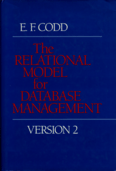The relational model for database managementversion 2
|

|
 Diese Seite wurde seit 4 Jahren inhaltlich nicht mehr aktualisiert.
Unter Umständen ist sie nicht mehr aktuell.
Diese Seite wurde seit 4 Jahren inhaltlich nicht mehr aktualisiert.
Unter Umständen ist sie nicht mehr aktuell.
 Zusammenfassungen
Zusammenfassungen
 An important adjunct to precision is a sound theoretical foundation. The relational model is solidly based on two parts of mathematics: firstorder predicate logic and the theory of relations. This book, however, does not dwell on the theoretical foundations, but rather on all the features of the relational model that I now perceive as important for database users, and therefore for DBMS vendors. My perceptions result from 20 years of practical experience in computing and data processing (chiefly, but not exclusively, with large-scale customers of IBM), followed by another 20 years of research.
An important adjunct to precision is a sound theoretical foundation. The relational model is solidly based on two parts of mathematics: firstorder predicate logic and the theory of relations. This book, however, does not dwell on the theoretical foundations, but rather on all the features of the relational model that I now perceive as important for database users, and therefore for DBMS vendors. My perceptions result from 20 years of practical experience in computing and data processing (chiefly, but not exclusively, with large-scale customers of IBM), followed by another 20 years of research.
I believe that this is the first book to deal exclusively with the relational approach. It does, however, include design principles in Chapters 21 and 22. It is also the first book on the relational model by the originator of that model. All the ideas in the relational model described in this book are mine, except in cases where I explicitly credit someone else.
In developing the relational model, I have tried to follow Einstein's advice, "Make it as simple as possible, but no simpler." I believe that in the last clause he was discouraging the pursuit of simplicity to the extent of distorting reality. So why does the book contain 30 chapters and two appendixes? To answer this question, it is necessary to look at the history of research and development of the relational model.
 Dieses Buch erwähnt ...
Dieses Buch erwähnt ...
 Begriffe KB IB clear |  Daten Daten data
, data
,  Datenbank Datenbank database
, Primärschlüsselprimary key database
, Primärschlüsselprimary key
|
 Tagcloud
Tagcloud
 Zitationsgraph
Zitationsgraph
 Zitationsgraph (Beta-Test mit vis.js)
Zitationsgraph (Beta-Test mit vis.js)
 2 Erwähnungen
2 Erwähnungen 
- Great Principles of Computing (Peter Denning, Craig Martell) (2015)


- Digitale Datenbanken - Eine Medientheorie im Zeitalter von Big Data (Marcus Burkhardt) (2015)


 Co-zitierte Bücher
Co-zitierte Bücher

Identität in Zeiten des Internet
Life on the Screen
Identity in the Age of the Internet
(Sherry Turkle) (1995)


 Volltext dieses Dokuments
Volltext dieses Dokuments
 |  The relational model for database management: Gesamtes Buch als Volltext ( The relational model for database management: Gesamtes Buch als Volltext ( : :  , 7294 kByte; , 7294 kByte;  : :  2020-11-28) 2020-11-28) |
 Anderswo suchen
Anderswo suchen 
 Beat und dieses Buch
Beat und dieses Buch
Beat hat dieses Buch während seiner Zeit am Institut für Medien und Schule (IMS) ins Biblionetz aufgenommen. Beat besitzt kein physisches, aber ein digitales Exemplar. Eine digitale Version ist auf dem Internet verfügbar (s.o.). Aufgrund der wenigen Einträge im Biblionetz scheint er es nicht wirklich gelesen zu haben. Es gibt bisher auch nur wenige Objekte im Biblionetz, die dieses Werk zitieren.











 Biblionetz-History
Biblionetz-History